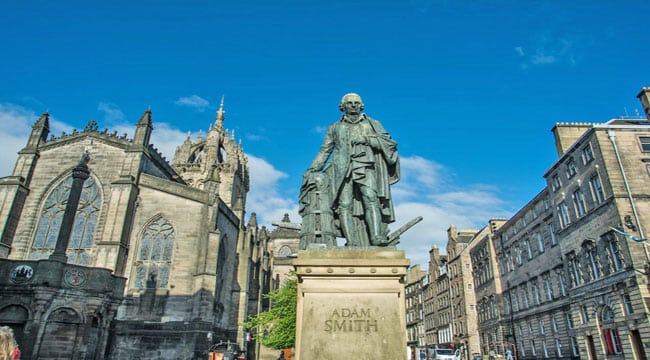
This short guide highlights some of the people and places associated with Adam Smith in Edinburgh.
Who was Adam Smith?
Adam Smith, (1723-1790) was a Scottish philosopher and economist who is widely considered as the “father of modern economics” and a pioneer in political economy.
His best-known work, An Inquiry into the Nature and Causes of the Wealth of Nations, was published in 1776.
Better known by its shortened title The Wealth of Nations, the book revolutionised economic thought and laid the foundation for classical economics.
The Adam Smith Institute (London) has a condensed copy of the Wealth of Nations to download. See the Institute link in the Research and Further Reading section below.
Adam Smith’s early life
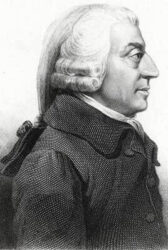
Adam Smith was born in Kirkcaldy, Fife in 1723, not in Edinburgh as some have suggested. While there is some doubt about the exact date, records show he was baptised on 5 June.
His father, also Adam Smith (1679–1723), was secretary to the third earl of Loudoun and later the Writer to the Signet.
His mother, Margaret Douglas (1694–1784), was the daughter of Robert Douglas of Strathenry.
As his father died some months before he was born it was his mother who brought him up.
He began his education at the local grammar school where he was introduced to Latin, Greek, Roman history and some rhetoric.
He left his hometown in 1737 at the tender age of 14 to enrol at the University of Glasgow. His studies included moral philosophy, metaphysics and maths.
His Professor of Mathematics was the influential Robert Simson and his Professor of Moral Philosophy was the remarkable Francis Hutcheson Hutcheson.
Hutcheson became a leading figure of the Scottish Enlightenment and had a profound effect on the young Scotsman.
Although he worked hard he never graduated from the university which was not unusual at the time.
In 1740, following receipt of a Snell Foundation bursary, Smith left Glasgow to begin life as a student at Balliol College Oxford.
Public lectures in Edinburgh
Returning to Scotland, Henry Home, Lord Kames invited Adam Smith Smith to give a series of public lectures in Edinburgh between 1748 and 1751 on rhetoric and belles-lettres.
It was an important time in Smith’s life, one where he was introduced to many of Edinburgh’s Enlightenment literati.
In 1764, Smith resigned his Glasgow chair and left academia behind to become tutor to the young Duke of Buccleuch who was about to set out on a tour of Europe.
His time in Europe allowed him to meet several influential economists and philosophers, including, in Geneva, Voltaire a man he greatly admired.
It’s believed that it was during his time in Europe that he began writing the Wealth of Nations.
In 1778, he unexpectedly took the post of Commissioner of Customs in Edinburgh with a yearly salary of £600 plus pension.
His new position prompted him to say he was now ‘fully as affluent as I could wish it to be.”
His work included collecting duty on imported goods and reducing smuggling in Scotland.
However, by 1787, he was back in Glasgow as the Rector of the University of Glasgow.
Adam Smith later described his time in Scotland’s largest city as:
“By far the most useful and therefore as by far the happiest and most honourable period of my life.”
Adam Smith
Adam Smith in Edinburgh
The most obvious reminder of Adam Smith’s connection to Edinburgh is the large statue (above) that stands close to St Giles’ Cathedral on Edinburgh’s Royal Mile.
David Hume
On the other side of the road, the statue of David Hume looks across at the man who became his friend. The men were two of the greatest thinkers of the Scottish Enlightenment.
Dennis C. Rasmussen a Professor of political science at Syracuse University sums up the relationship in his book: The Infidel and The Professor: David Hume, Adam Smith and the Friendship that Shaped Modern Thought.
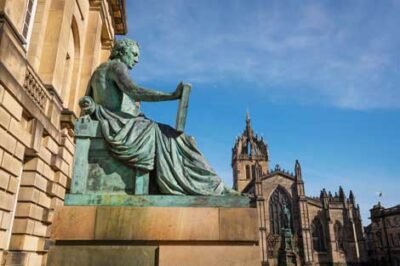
This excellent book is reviewed by the London School of Economics (LSE).
In 1783, Adam Smith became a founding Fellow of the Royal Society of Edinburgh (RSE). The first meeting took place in the Old Library of Edinburgh University in June of that year.
In 2023, the RSE, the University of Glasgow and others celebrated the tercentenary of Adam Smith’s birth.
Edinburgh’s Convivial Clubs
Edinburgh’s convivial clubs and societies flourished during the Scottish Enlightenment.
They fostered intellectual discourse, debate and socialising, providing a fertile ground for the exchange of ideas.
.Adam Smith was an active member of several of these clubs. Among them was the Select Society, a club he helped found in 1754 with David Hume and others.
He was also a member of the Oyster Club and the Poker Club with David Hume and William Robertson the Principal of the University of Edinburgh
- This article on Truly Edinburgh says more about Edinburgh’s convivial clubs and societies in the 18th century.
Adam Smith’s Edinburgh home: Panmure House
Adam Smith moved into Panmure House which sits on the Canongate, part of the Royal Mile, and close to the Palace of Holyroodhouse.
He lived there with with his mother and cousin Janet Douglas along with the cousin’s nephew, David Douglas, who became Smith’s heir.
Historic Environment Scotland describes the house, originally built in 1691. as a ” Late C17th L-plan tower house, built as town house for the Earls of Panmure.”
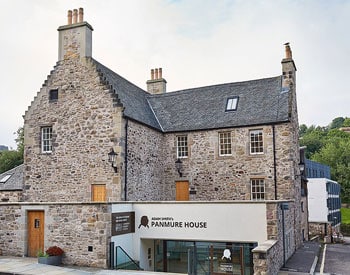
The Maule’s of Panmure were a family with Norman origins that later became landowners in Angus.
Patrick Maule, the first Earl of Panmure, for example, was a pageboy to James VI of Scotland.
Moving on to the 18th century it seems the Maules chose the losing side during the 1715 Jacobite Uprising.
While living at Panmure House Adam Smith wrote another four editions of the Wealth of Nations.
Given Smith’s membership of some of Edinburgh’s convivial clubs, we know that he was fond of socialising. His popular Sunday suppers at Panmure House were another example of that.
These regular gatherings were opportunities for him to meet with his fellow literati to discuss Enlightenment matters.
Today, Heriot Watt University (Edinburgh Business School) owns the building. It was reopened in 2018 after extensive renovation.
Heriot Watt’s mission statement says, “Today the house is a centre of excellence for the study of contemporary economics, a place of reflection on the legacy of Adam Smith, and a venue for social and economic debate…”
The link to Panmure House in the Research and Further Reading section below will take you to further information.
Note about Panmure House
Panmure House, the final home of Adam Smith in Edinburgh is not to be confused with Panmure House or Panmure Castle in Angus
Adam Smith is buried in Edinburgh’s Canongate Kirk Cemetery
Adam Smith died in 1790, in Panmure House.
According to D. Stewart writing in ‘Account of the Life and Writings of Adam Smith’, Transactions of the Royal Society of Edinburgh (1794) Adam Smith died of a “chronic obstruction in his bowels. “
James Hutton, often considered the ‘father of geology’ and a regular visitor to Panmure House was the executor of Adam Smith’s will. The friends would have enjoyed each other’s company at Edinburgh’s Oyster Club on Niddrie Street South in the Old Town.
He was buried in the nearby Canongate Cemetery on 22 July. The cemetery is attached to the historic Canongate Kirk.
The Royal Society of Edinburgh described Hutton as ” one of the titans of the Enlightenment.”
The cemetery is also the final resting place of the poet Robert Fergusson. Smith’s friend and. professor of philosophy at the University of Edinburgh. Dugald Stewart was an important figure during these golden years.
Intriguingly, ‘tradition’ dictates that the murdered David Rizzio, private secretary and companion to Mary Queen of Scots also lies at rest in the graveyard although there is no visible evidence.
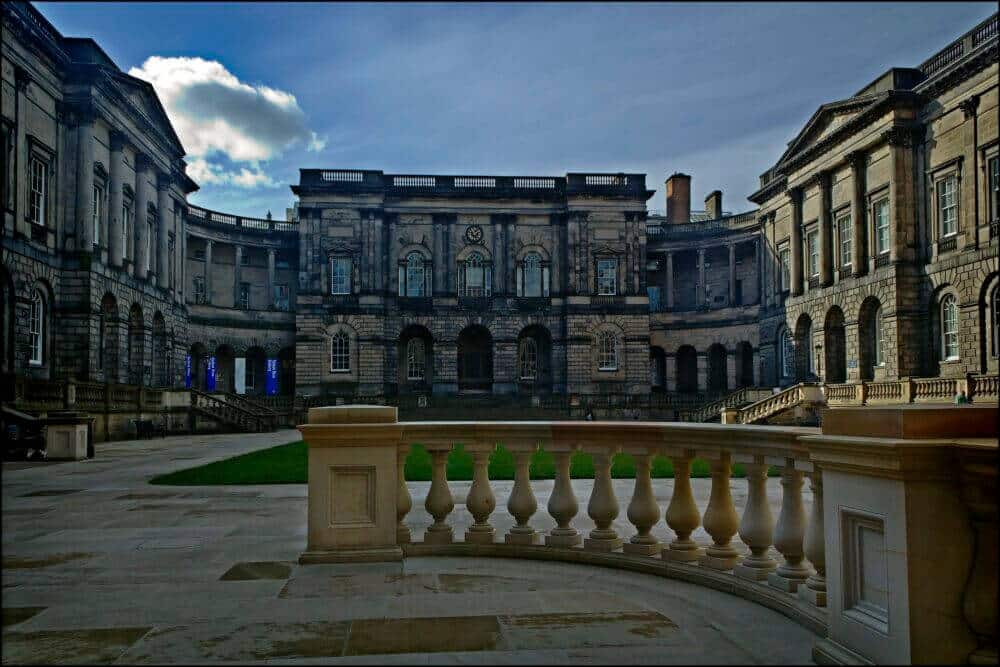
The Scottish Enlightenment and Edinburgh
The Scottish Enlightenment was a golden age that saw a remarkable flourishing of intellectual activity in Edinburgh and other Scottish cities.
Adam Smith played a prominent part in this important period of Scotland’s history.
Adam Smith: research and further reading
For those interested in learning more about the life of Adam Smith in Edinburgh and beyond the following authoritative sources are very helpful for further reading.
- Panmure House, Edinburgh
- The University of Edinburgh Adam Smith Collection
- The Adam Smith Institute
- The National Records of Scotland
- Biography of Adam Smith, Princeton University
- University of Glasgow, Adam Smith
Truly Edinburgh has used these sources to ensure the accuracy of this article.